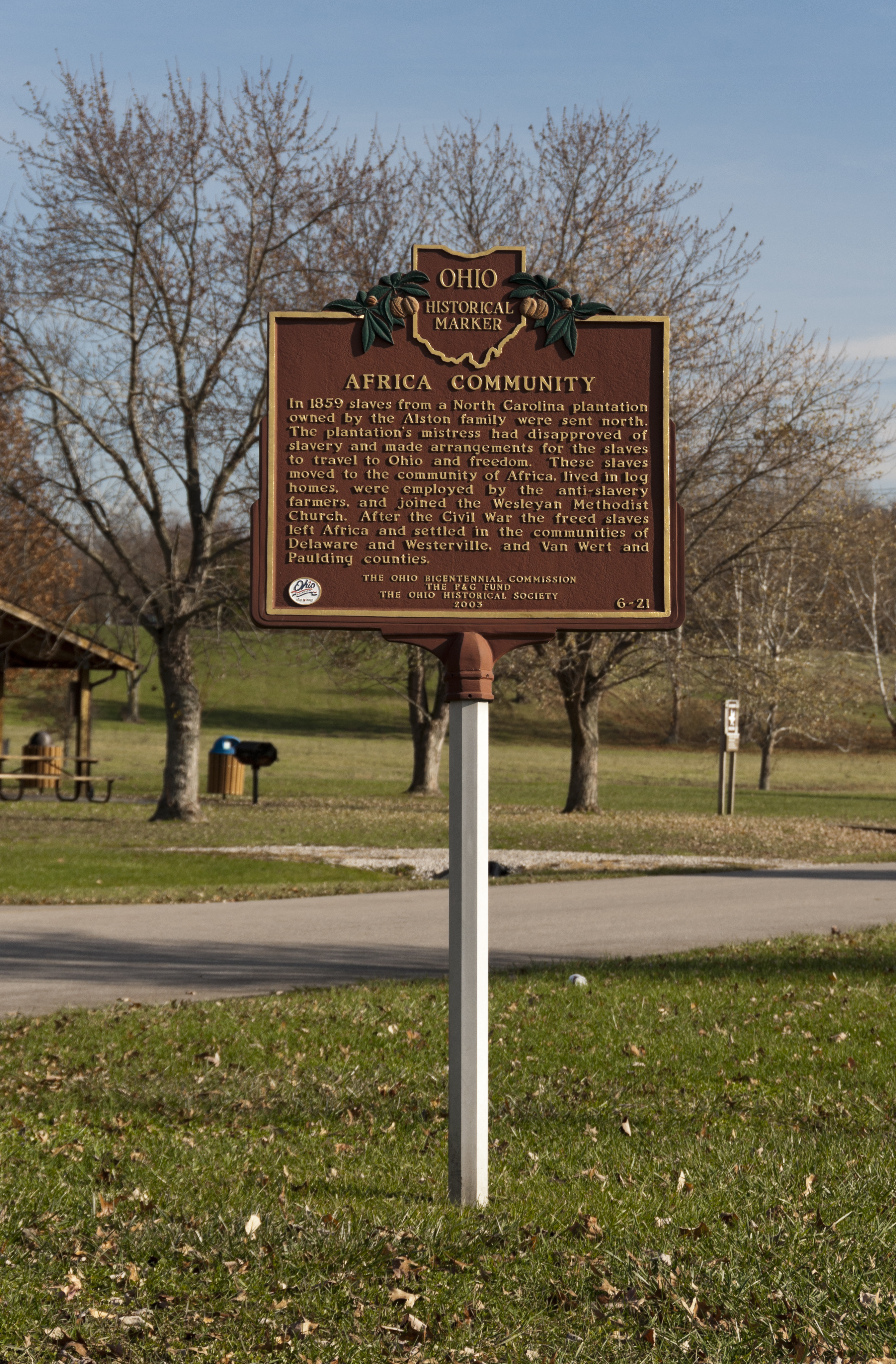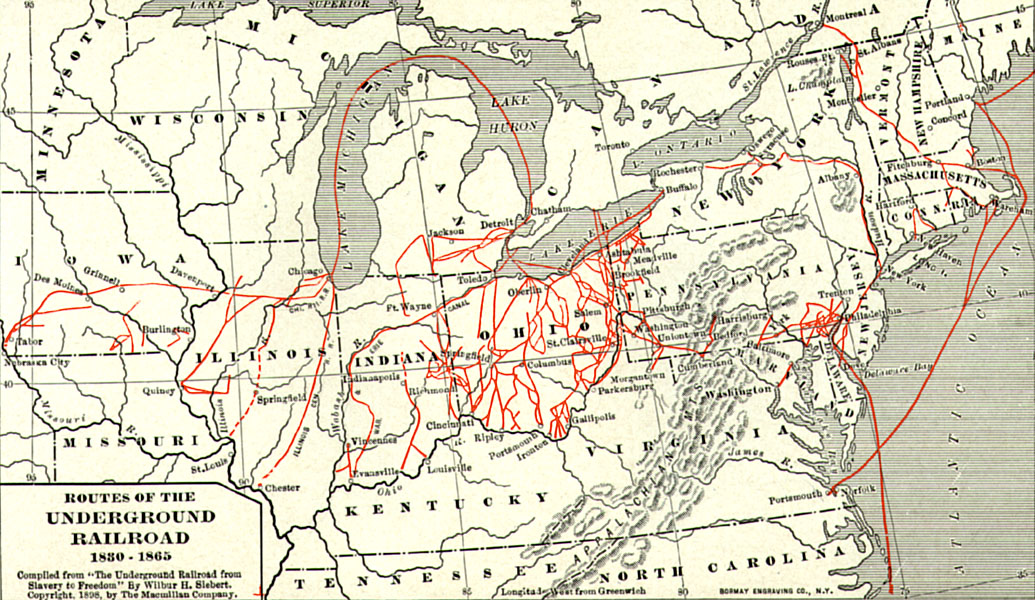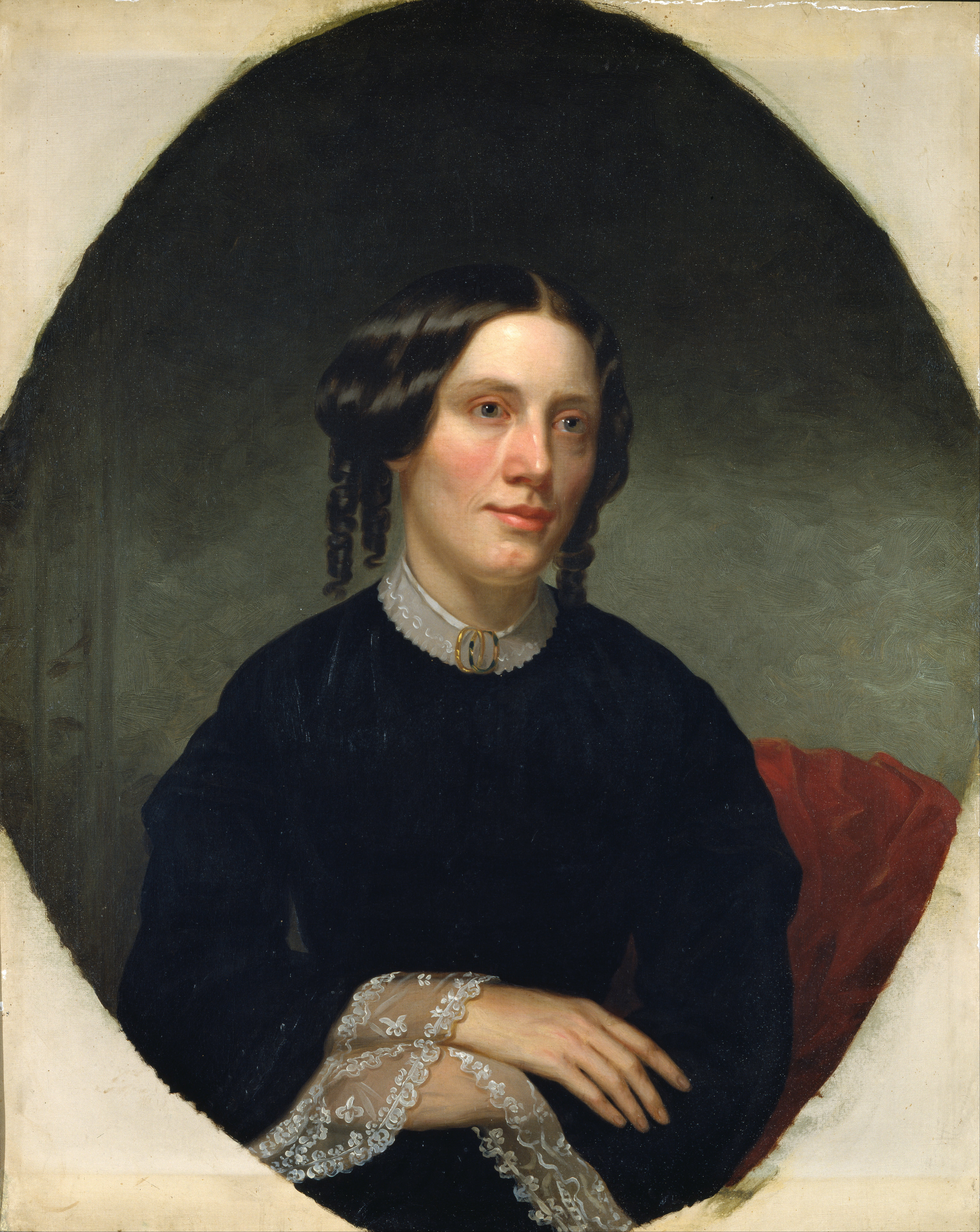|
Africa, Ohio
Africa is an unincorporated community located in Orange Township of southern Delaware County, Ohio, United States, by Alum Creek. History Africa is named after the Underground Railroad and is thought to be the only town in the world named after the Underground Railroad. Its first church is thought to have been a Methodist church that was established on the east side of Alum Creek in approximately 1828. In 1843, the slavery question separated its congregation. The antislavery portion organized the Wesleyan Church on the east side of Alum Creek. The first services were held in a cabin on the Alum Creek flats near the Patterson residence. In 1876, members of the congregation built a church, located in present-day Africa. A historic marker in the area recounts the history of how the community was divided by the slavery question and of how Africa received its name: Samuel Patterson arrived in East Orange in 1824 and, within a few years, began to hide runaway slaves in his home. He ... [...More Info...] [...Related Items...] OR: [Wikipedia] [Google] [Baidu] |
Unincorporated Area
An unincorporated area is a region that is not governed by a local municipal corporation. Widespread unincorporated communities and areas are a distinguishing feature of the United States and Canada. Most other countries of the world either have no unincorporated areas at all or these are very rare: typically remote, outlying, sparsely populated or List of uninhabited regions, uninhabited areas. By country Argentina In Argentina, the provinces of Chubut Province, Chubut, Córdoba Province (Argentina), Córdoba, Entre Ríos Province, Entre Ríos, Formosa Province, Formosa, Neuquén Province, Neuquén, Río Negro Province, Río Negro, San Luis Province, San Luis, Santa Cruz Province, Argentina, Santa Cruz, Santiago del Estero Province, Santiago del Estero, Tierra del Fuego Province, Argentina, Tierra del Fuego, and Tucumán Province, Tucumán have areas that are outside any municipality or commune. Australia Unlike many other countries, Australia has only local government in Aus ... [...More Info...] [...Related Items...] OR: [Wikipedia] [Google] [Baidu] |
Dan Emmett
Daniel Decatur Emmett (October 29, 1815June 28, 1904) was an American songwriter, entertainer, and founder of the first troupe of the blackface minstrel tradition, the Virginia Minstrels. He is most remembered as the composer of the song "Dixie". Early and family life Dan Emmett was born in Mount Vernon, Knox County, Ohio, then a frontier region. His grandfather, Rev. John Emmett (1759–1847) had been born in Cecil County, Maryland, and after serving as a private in the American Revolutionary War and fighting at the Battle of White Plains in New York and later in Delaware, became a Methodist minister in the then-vast frontier Augusta County, Virginia, and then moved across the Appalachian Mountains to Licking County, Ohio and also served in the Ohio legislature representing Pickaway County, Ohio in the Scioto River valley. His father, Abraham Emmett (1791–1846) served as a private in the War of 1812 while his father served in the Ohio legislature. Notwithstanding his g ... [...More Info...] [...Related Items...] OR: [Wikipedia] [Google] [Baidu] |
Populated Places On The Underground Railroad
Population typically refers to the number of people in a single area, whether it be a city or town, region, country, continent, or the world. Governments typically quantify the size of the resident population within their jurisdiction using a census, a process of collecting, analysing, compiling, and publishing data regarding a population. Perspectives of various disciplines Social sciences In sociology and population geography, population refers to a group of human beings with some predefined criterion in common, such as location, race, ethnicity, nationality, or religion. Demography is a social science which entails the statistical study of populations. Ecology In ecology, a population is a group of organisms of the same species who inhabit the same particular geographical area and are capable of interbreeding. The area of a sexual population is the area where inter-breeding is possible between any pair within the area and more probable than cross-breeding with ind ... [...More Info...] [...Related Items...] OR: [Wikipedia] [Google] [Baidu] |
African-American History Of Ohio
African Americans (also referred to as Black Americans and Afro-Americans) are an ethnic group consisting of Americans with partial or total ancestry from sub-Saharan Africa. The term "African American" generally denotes descendants of enslaved Africans who are from the United States. While some Black immigrants or their children may also come to identify as African-American, the majority of first generation immigrants do not, preferring to identify with their nation of origin. African Americans constitute the second largest racial group in the U.S. after White Americans, as well as the third largest ethnic group after Hispanic and Latino Americans. Most African Americans are descendants of enslaved people within the boundaries of the present United States. On average, African Americans are of West/ Central African with some European descent; some also have Native American and other ancestry. According to U.S. Census Bureau data, African immigrants generally do not self ... [...More Info...] [...Related Items...] OR: [Wikipedia] [Google] [Baidu] |
American Civil War
The American Civil War (April 12, 1861 – May 26, 1865; also known by other names) was a civil war in the United States. It was fought between the Union ("the North") and the Confederacy ("the South"), the latter formed by states that had seceded. The central cause of the war was the dispute over whether slavery would be permitted to expand into the western territories, leading to more slave states, or be prevented from doing so, which was widely believed would place slavery on a course of ultimate extinction. Decades of political controversy over slavery were brought to a head by the victory in the 1860 U.S. presidential election of Abraham Lincoln, who opposed slavery's expansion into the west. An initial seven southern slave states responded to Lincoln's victory by seceding from the United States and, in 1861, forming the Confederacy. The Confederacy seized U.S. forts and other federal assets within their borders. Led by Confederate President Jefferson Davis, ... [...More Info...] [...Related Items...] OR: [Wikipedia] [Google] [Baidu] |
Alum Creek State Park
Alum Creek State Park is a Ohio state park in Delaware County, Ohio, in the United States. Alum Creek Lake was constructed from 1970 to 1974 as part of the Flood Control Act of 1962. Alum Creek Dam was constructed on Alum Creek, a tributary of Big Walnut Creek, which drains into the Scioto River. Alum Creek Reservoir holds of water and is open to fishing, boating, ice fishing, ice boating and swimming. The park is just north of the state capital of Columbus and contains the remnants of a settlement by freed slaves that arrived in Ohio from North Carolina. History Native Americans The first evidence of man living in the Alum Creek State Park area dates back over 2,000 years ago to the Adena culture. The Adena were a Pre-Columbian Native American culture that existed from 1000 BC to 200 BC, in a time known as the early Woodland Period. The Adena culture refers to what were probably a number of related Native American societies sharing a burial complex and ceremonial system. S ... [...More Info...] [...Related Items...] OR: [Wikipedia] [Google] [Baidu] |
Uncle Tom's Cabin
''Uncle Tom's Cabin; or, Life Among the Lowly'' is an anti-slavery novel by American author Harriet Beecher Stowe. Published in two volumes in 1852, the novel had a profound effect on attitudes toward African Americans and slavery in the U.S., and is said to have "helped lay the groundwork for the mericanCivil War". Stowe, a Connecticut-born woman of English descent, was part of the religious Beecher family and an active abolitionist. She wrote the sentimental novel to depict the reality of slavery while also asserting that Christian love could overcome slavery. The novel focuses on the character of Uncle Tom, a long-suffering black slave around whom the stories of the other characters revolve. In the United States, ''Uncle Tom's Cabin'' was the best-selling novel and the second best-selling book of the 19th century, following the Bible. It is credited with helping fuel the abolitionist cause in the 1850s. The influence attributed to the book was so great that a likely ... [...More Info...] [...Related Items...] OR: [Wikipedia] [Google] [Baidu] |
Harriet Beecher Stowe
Harriet Elisabeth Beecher Stowe (; June 14, 1811 – July 1, 1896) was an American author and abolitionist. She came from the religious Beecher family and became best known for her novel ''Uncle Tom's Cabin'' (1852), which depicts the harsh conditions experienced by enslaved African Americans. The book reached an audience of millions as a novel and play, and became influential in the United States and in Great Britain, energizing anti-slavery forces in the American North, while provoking widespread anger in the South. Stowe wrote 30 books, including novels, three travel memoirs, and collections of articles and letters. She was influential both for her writings and for her public stances and debates on social issues of the day. Life and work Harriet Elisabeth Beecher was born in Litchfield, Connecticut on June 14, 1811.McFarland, Philip. ''Loves of Harriet Beecher Stowe''. New York: Grove Press, 2007: 112. She was the sixth of 11 children born to outspoken Calvinist preache ... [...More Info...] [...Related Items...] OR: [Wikipedia] [Google] [Baidu] |
Otterbein College
Otterbein University is a private university in Westerville, Ohio. It offers 74 majors and 44 minors as well as eight graduate programs. The university was founded in 1847 by the Church of the United Brethren in Christ and named for United Brethren founder the Rev. Philip William Otterbein. As a result of a division and two mergers involving the church, it has been associated since 1968 with the United Methodist Church. In 2010, its name was changed back from Otterbein College to Otterbein University because of an increasing number of graduate and undergraduate programs. It is primarily an undergraduate institution with approximately 2,300 undergraduate and 450 graduate students on the campus. Otterbein has over 100 student organizations and a popular Greek presence. The school's mascot is Cardy the Cardinal and the school is a member of the Ohio Athletic Conference in NCAA Division III athletics. History Otterbein University was founded in 1847 by the Church of the Unite ... [...More Info...] [...Related Items...] OR: [Wikipedia] [Google] [Baidu] |
Benjamin Hanby
Benjamin Russell Hanby (July 22, 1833 – March 16, 1867), also given as Benjamin Russel Hanby, was an American composer, educator, pastor, and abolitionist who wrote approximately 80 songs. The most famous are "Darling Nelly Gray" and the Christmas songs "Up on the House Top" and "Who Is He In Yonder Stall?". Hanby was born in Rushville, Ohio. He moved to Westerville, Ohio in 1849, at the age of sixteen, to enroll at Otterbein University. He was involved in the Underground Railroad with his father, Bishop William Hanby. Hanby composed the popular anti-slavery ballad ''Darling Nelly Gray'' in 1856 in what is now a national historical site, the Hanby House, located at the corner of Grove and Main Streets (in the 1830s, when Hanby was still a child his family moved to 160 West Main Street) in Westerville, adjacent to the campus of Otterbein University. The song was based on the Hanby family’s encounter with Joseph Selby, a runaway slave from Kentucky who died at the Han ... [...More Info...] [...Related Items...] OR: [Wikipedia] [Google] [Baidu] |
Westerville, Ohio
Westerville is a city in Franklin and Delaware counties in the U.S. state of Ohio. A northeastern suburb of Columbus, the population was 39,190 at the 2020 census. Westerville is the home of Otterbein University. Westerville was once known as "The Dry Capital of the World" for its strict laws prohibiting sales of alcohol and for being the home of the Anti-Saloon League, one of the driving forces behind Prohibition at the beginning of the 20th century. History Native Americans Cultures have inhabited the Westerville area for several millennia. Paleo-Indians and their successor cultures inhabited the area between Big Walnut Creek and Alum Creek. The Wyandot were the primary inhabitants by the time Europeans arrived, living along Alum Creek. They were forced out of Ohio in 1843. Post-Ohio statehood The land that is today Westerville was settled by those of European ancestry around 1810. In 1818, Matthew, Peter, and William Westervelt, settlers of Dutch extraction, migrated ... [...More Info...] [...Related Items...] OR: [Wikipedia] [Google] [Baidu] |








